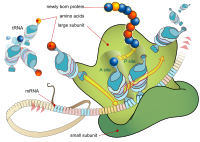
Photo from wikipedia
Pathogenic bacteria frequently acquire virulence traits via horizontal gene transfer, yet additional evolutionary innovations may be necessary to integrate newly acquired genes into existing regulatory pathways. The plant bacterial pathogen… Click to show full abstract
Pathogenic bacteria frequently acquire virulence traits via horizontal gene transfer, yet additional evolutionary innovations may be necessary to integrate newly acquired genes into existing regulatory pathways. The plant bacterial pathogen Pseudomonas syringae relies on a horizontally acquired type III secretion system (T3SS) to cause disease. T3SS-encoding genes are induced by plant-derived metabolites, yet how this regulation occurs, and how it evolved, is poorly understood. Here we report that the two-component system AauS-AauR and substrate-binding protein AatJ, proteins encoded by an acidic amino acid-transport (aat) and -utilization (aau) locus in P. syringae, directly regulate T3SS-encoding genes in response to host aspartate and glutamate signals. Mutants of P. syringae strain DC3000 lacking aauS, aauR or aatJ expressed lower levels of T3SS genes in response to aspartate and glutamate, and had decreased T3SS deployment and virulence during infection of Arabidopsis. We identified an AauR-binding motif (Rbm) upstream of genes encoding T3SS regulators HrpR and HrpS, and demonstrated that this Rbm is required for maximal T3SS deployment and virulence of DC3000. The Rbm upstream of hrpRS is conserved in all P. syringae strains with a canonical T3SS, suggesting AauR regulation of hrpRS is ancient. Consistent with a model of conserved function, an aauR deletion mutant of P. syringae strain B728a, a bean pathogen, had decreased T3SS expression and growth in host plants. Together, our data suggest that, upon acquisition of T3SS-encoding genes, a strain ancestral to P. syringae co-opted an existing AatJ-AauS-AauR pathway to regulate T3SS deployment in response to specific host metabolite signals.
Journal Title: PLoS Pathogens
Year Published: 2020
Link to full text (if available)
Share on Social Media: Sign Up to like & get
recommendations!